7 Easy Tabletop Houseplants
Success with houseplants starts with choosing the right plant for you. Often, that means starting with something small and easy (think smaller investment of money and time). We’ve narrowed down a list of our favorite houseplants that will help you turn your thumb from brown to green. A tabletop houseplant means anything that can be placed on a table, shelf, credenza, desk, buffet, etc. In houseplant terms, these are usually 4″, 6″, & 8″ pot sizes.
Snake Plant
Snake Plants (Sansevieria, Mother in Law Tongues) are about as easy as it gets. Snake Plants come in a variety of different leaf patterns, shapes, sizes & forms. There are taller growing varieties can be used for floor plants. They are tall or short, with round, flat or concave leaves, and variegated with dark green, silver, light green, yellow, chartreuse or white.

Snake Plant Care Tips
- Water – infrequent watering and need to be careful not to overdo it because the plant will rot. You always make sure the soil is almost completely dry before thoroughly watering again. Typically water Snake Plants every 2-6 weeks, depending on your home’s temperature, light levels, and humidity.
A great plant for those that travel or have a tendency to ignore plants.
- Lighting – Low to medium light. Even though Snake Plants tend to prefer medium light (which is about 10′ away from the west or south window), they’ll also tolerate low light and high light. They do however need to be kept out of the direct sun.
ZZ Plant
ZZ Plants (Zamioculcas, Zanzibar Gem) have beautiful foliage & have become quite popular in the last several years. They have a beautiful dark green foliage that is somewhat glossy or shiny in appearance. Larger ZZ Plants can also be used as a floor plant.
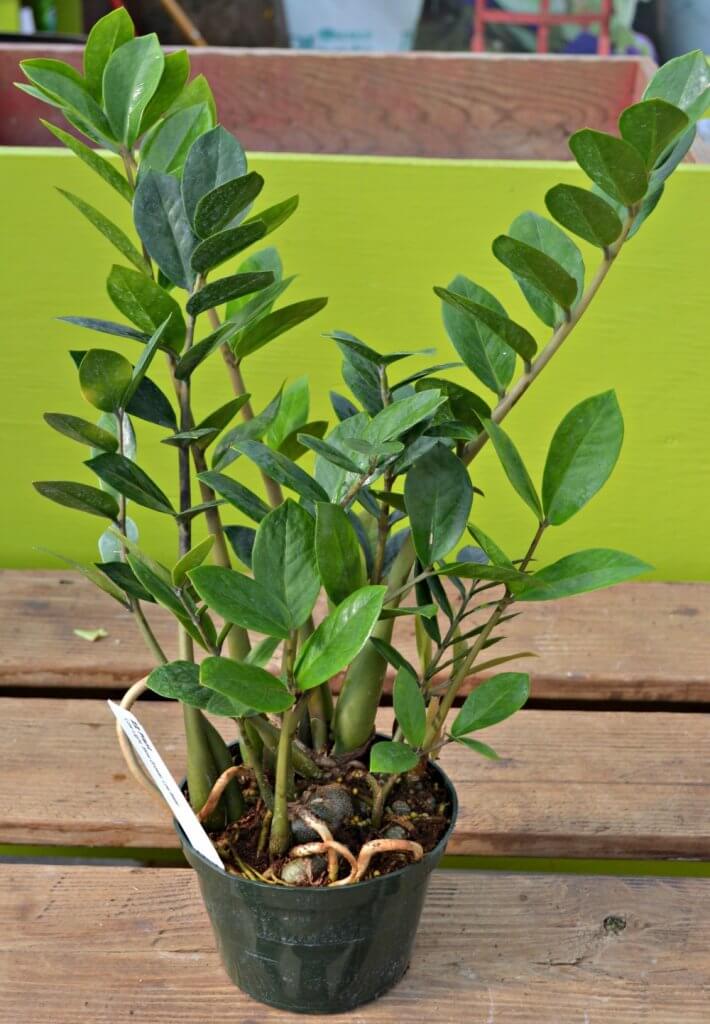
ZZ Plant Care Tips
- Watering – Infrequent watering. Approximately every 2-3 weeks in summer & every 3-4 weeks in winter. Adjust accordingly for your conditions. These plants grow from thick, round tuberous rhizomes which store water as do the thick, fleshy roots & somewhat spongy stems. Therefore, it’s important that you don’t overwater a ZZ Plant.
- Lighting – Medium light is the key for this plant to look its best. They can tolerate low light plant but that will result in little new growth & somewhat stretchy stems. If you have a room with moderate to high light, keep your ZZ at least 10′ away from any windows.
Pothos
Pothos (Epipremnum, Devil’s Ivy) is one of the easiest trailing houseplants there is and it’s great in hanging containers.
They come with solid green foliage or with variegation & chartreuse foliage. The solid green would be the one that would tolerate the lower light. The ones with variegation & chartreuse foliage need medium light.
Pothos are moderate to fast growers. If you have it in low light, the growth rate will be slower.
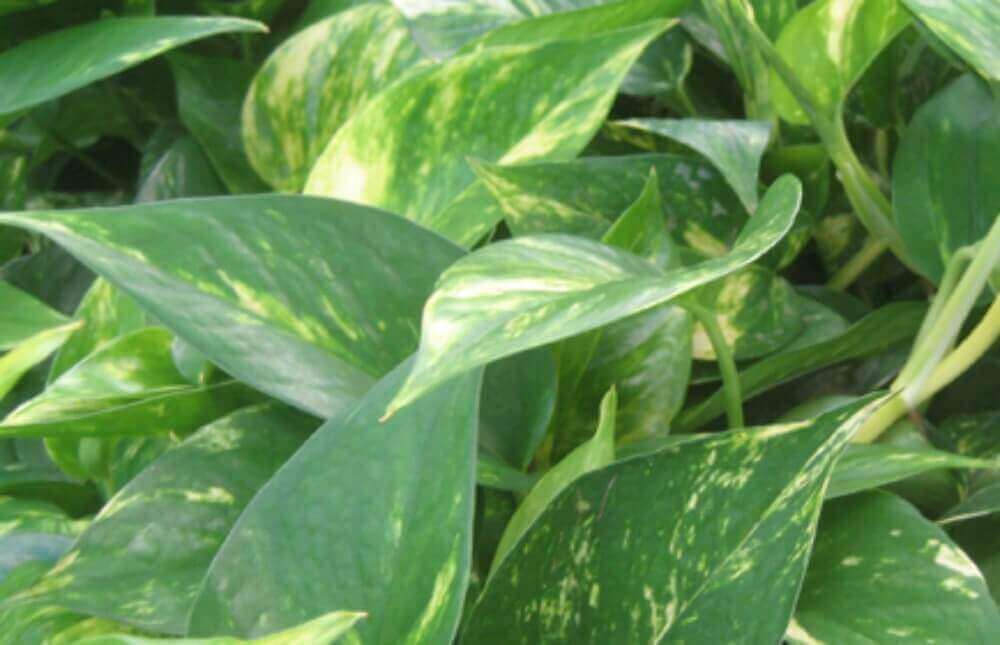
Pothos Care Tips
- Watering – water thoroughly until the water drains out of the pot & let the soil go almost dry before watering again.
How often you water a Pothos depends on how warm your home is, pot size, type of pot, etc. Pothos are subject to root rot when overwatered so it’s better to keep them on the dry side rather than too wet. In the colder months, water less often.
- Lighting – Low to Medium. Moderate light is the best for Pothos. They’ll tolerate low light but will have limited growth. And in low light conditions, a Golden Pothos will lose its variegation & revert to solid green. And, their leaves also get smaller if they’re not getting enough light.
Spider Plant
Spider Plants (Chlorophytum, Airplane Plant) are another easy hanging/trailing plant option. These trailing plants are often found in green/white & green/chartreuse color combinations.
Spider Plants are tolerant of a wide range of conditions. They are adaptable & durable, making them one of the easiest houseplants around to care for.

Spider Plant Care Tips
- Watering – Low to average depending on how warm & bright the environment is. Water them when they’re almost dry & be sure to let the water drain all the way through the pot. If your water is high in salts, consider using distilled water.
Tip: consider taking hanging plants to a sink when watering as this will take any guesswork out of when the water would come spilling out.
- Lighting – Medium to high light. They are very adaptable to lighting but do prefer nice bright light (like a west, north or east window) but will also do fine in lower light conditions. However, if you have a variegated variety, it could revert to solid green if there is too little light.
Aloe Vera
Aloe Vera (Aloe barbedensis, Aloe, First Aid Plant) is a succulent & requires bright light for it to do well. A very easy care succulent to grow as a houseplant. If the plants are happy, you’ll see pups (babies) appearing from the base of the mother plant.
A very handy plant to have in the kitchen or a bathroom as the plump leaves are full of gel and can be used for a variety of healing properties.
The larger it gets, the heavier it gets because those large leaves store a lot of water & of course the gooey gel.
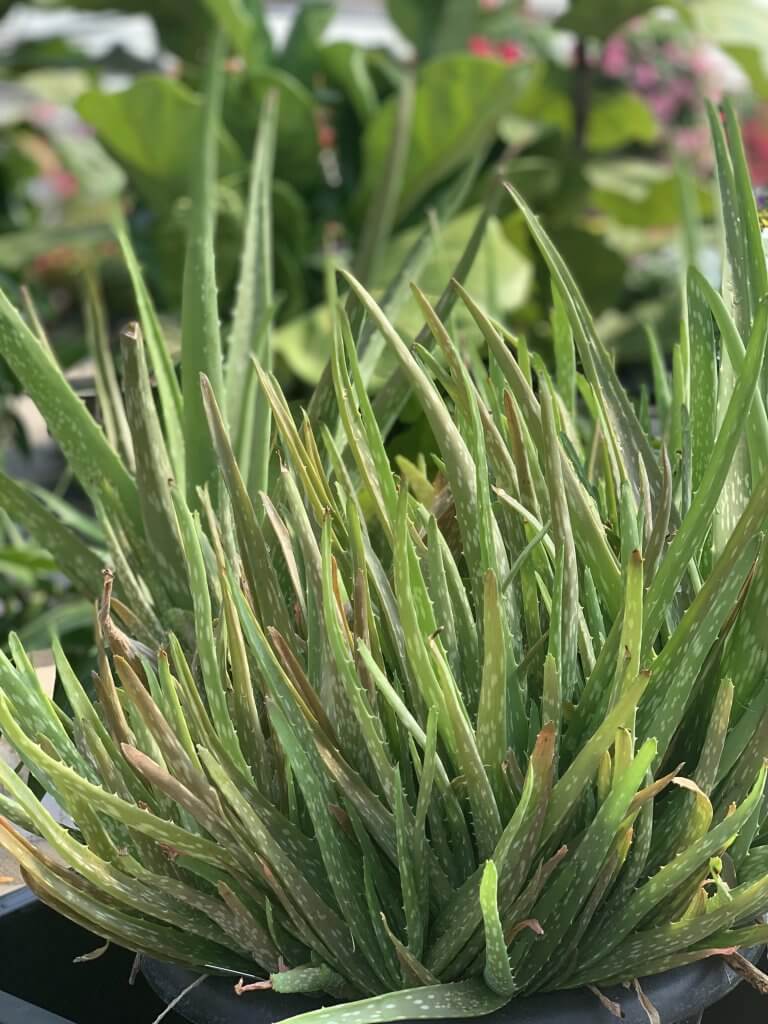
Aloe Vera Care Tips
- Watering – easy does it, when it comes to frequency. This fleshy succulent stores a lot of water in its leaves & thick roots. Depending on your environmental conditions, you will probably want to water your Aloe Vera every 2-4 weeks.
With this plant, it’s best to water less often than more often. If you Aloe begins to smell, then it’s rotting out. Dark, transparent spots or crimping at the base of the leaves are also signs of too much water.
- Lighting – Medium to high light. This succulent needs a fair amount of bright, natural light to grow and for those leaves to get nice & plump. A south or west exposure area in your home is best. East can be fine too as long as it’s quite close to a window. You’ll want to rotate it every few months or so to make sure the light its receiving is even on all sides.
In the winter with shorter days, you may have to move it to a sunnier spot. In the summer though, be sure to keep it out of any hot, direct sun lighted windows because that could burn the leaves. If you have a dark home or apartment, this would not be a recommended plant to try.
Jade Plant
The jade plant is a very popular succulent houseplant with fleshy, oval-shaped leaves. It sometimes is called or referred to as the money plant or dollar plant.
Jade plant care is easy and simple. Many people enjoy growing jade plants in their homes and offices, and they are considered to be symbols of good luck.
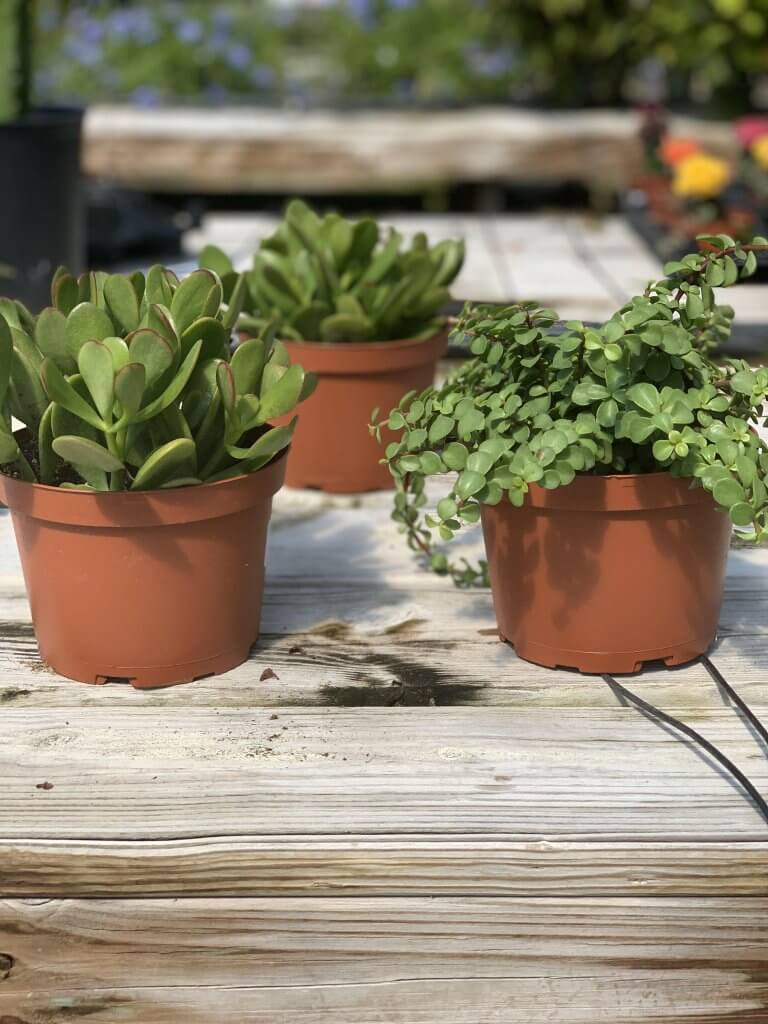
Jade plants belong to the Crassula family and are generally undemanding. They need an even hand with water and plenty of light to develop their full potential. Given proper conditions, the jade plant will produce white flowers in the late winter, making an attractive and mildly fragrant display.
Jade Plant Care Tips
- Lighting – Jade plants prefer full sun and like four or more hours of sunlight each day. They are best in a room with south-facing windows.
- Water – during the summer and spring, Jade plants should be watered often so the soil is moist but not wet, making sure drainage is immaculate. Reduce watering to monthly in the winter.
Never let a Jade plant dry out completely. But also, do not water it too often either, as this can cause root rot. Don’t water your jade plant on a schedule. Instead, water your it when the top of the soil is just dry to the touch. If your jade plant is losing leaves or has leaf spots, this is most commonly caused by too little water.
- Temperature – they prefer average summer temperatures of 65 F to 70 F. In winter, cool to 50 F.
Air Plant
Few plants are as forgiving as those in the Tillandsia genus. These epiphytes live perched on branches in frost-free environments, taking the moisture they need from the air using specially adapted scales on their spiky leaves.
Air plants absorb moisture and nutrients through their leaves, instead of through their roots. Any roots present on members of the Tillandsia genus are used for securing the plant to the tree on which it lives. Some varieties of air plants are large with broad, strap-like leaves, while others are tiny with thread-like leaves.
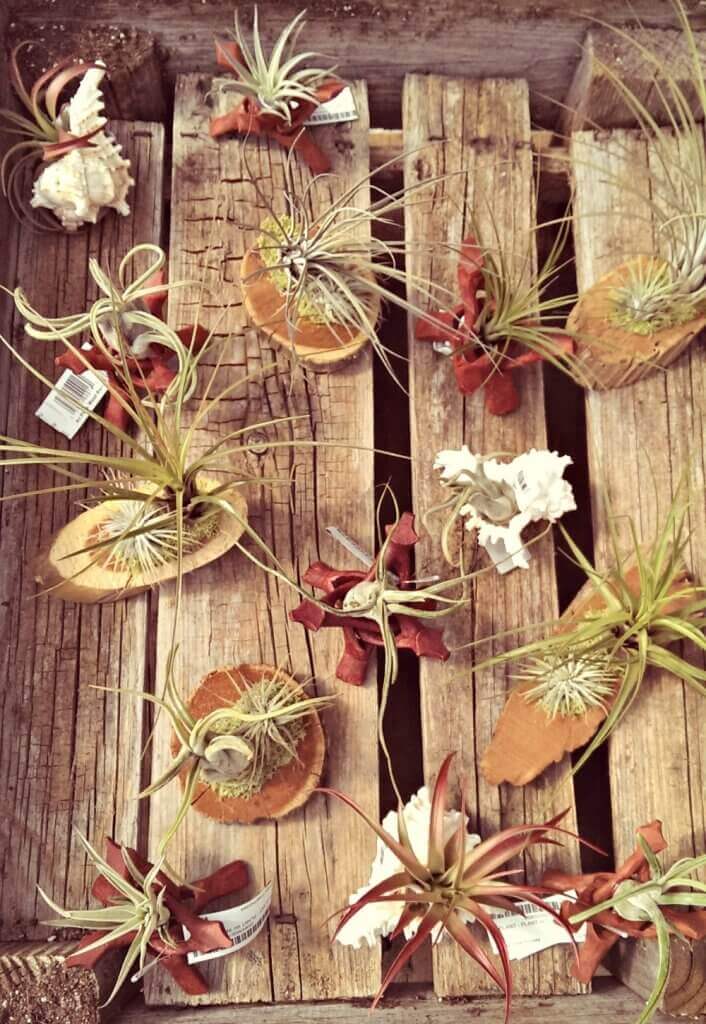
You can mount them on driftwood, arrange them in a basket, or create a soil-free mini terrarium for these mess-free plants. They grow very slowly, and need little more than partial sunlight and a weekly dunking in water to stay hydrated.
Since air plants absorb moisture through their leaves, they prefer warm, humid conditions. Most homes are not humid enough for air plants, especially during the winter months. So, caring for air plants means keeping the plants regularly watered.

Note: Bathrooms and kitchens make great air plant homes due to their high moisture levels after showers, dish washing, and other humidity-generating activities. Rooms where fans are left constantly running are poor choices for air plants. The moving air causes the plant to dry out more quickly.
Air Plant Care Tips
- Watering
- Watering air plants via misting: For this method, use a spray bottle or plant mister to spritz air plants with water every day or two. After spraying the entire plant, place the damp air plant on a towel to dry for a few hours before putting it back in its decorative container or arrangement.
- Watering air plants in a bowl or sink of water: This is the best method of watering air plants as it allows the water to soak into the plants. To water air plants this way, fill a bowl or sink with water and float the air plants in the water for 20 minutes to an hour every week. Then, take the plants out of the water, tip them upside down so any excess water can drain away, and then place them on a towel to dry before putting them back on display
- Lighting
- Air plants like bright but filtered light best. A west, east, or south-facing window will do nicely. If you don’t think your air plant is getting enough light, supplemental lighting via a fluorescent light or a table-top grow light helps.
- Tillandsias enjoy spending the summer outdoors, but be sure to put them in a location with filtered sunlight. Direct sun during the hot summer months will burn them. And be sure to move the plants back indoors well before fall’s first frost.




